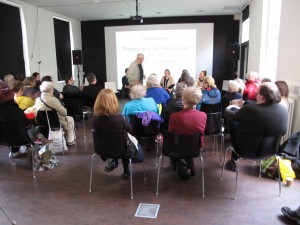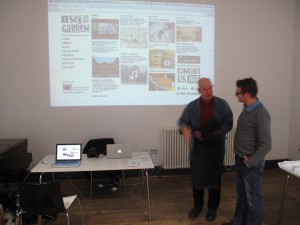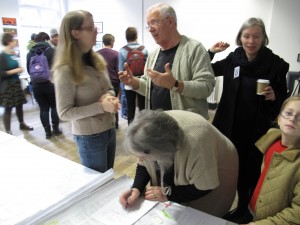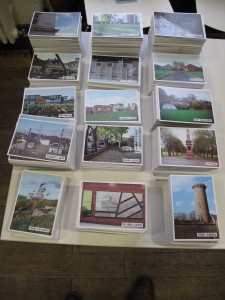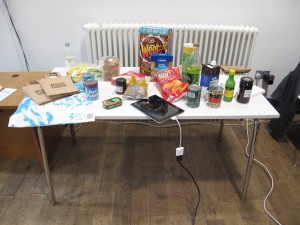Mr Seel Show and Tell at The Bluecoat
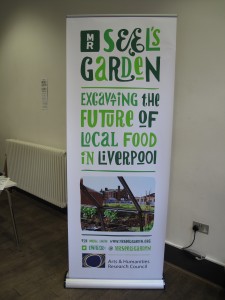 Sunday 27th January was a big day for the Memories of Mr Seel’s Garden project. Months of preparation – and last-minute efforts – were due to come to fruition. We had a full menu of treats in store.
Sunday 27th January was a big day for the Memories of Mr Seel’s Garden project. Months of preparation – and last-minute efforts – were due to come to fruition. We had a full menu of treats in store.
The new website was launched last week and we were all excited about its look and feel – particularly the improved map, which can now be sorted for researchers interested in different types of location.
Equally keenly anticipated was the new app, which turns barcodes into stories, uncovered through our archive and oral history research.
And we were all eager to get our hands on the 15 new postcards and the food packaging (bags and napkins), which we’ve produced for other local food activists and local cafés.
Finally, this would be the first opportunity for Eleanor Rees, our associated poet, to read pieces inspired by the oral histories and for the performance of our play, created by our volunteers in association with Liz Postlethwaite, based on a mixture of story-telling and readings from our oral histories.
The day dawned, bright and sunny – and we were ready to go…
The event involved two parts: ‘Show’ and ‘Tell’. The ‘Show’ room was for visitors to see some of the materials we have been working with and some of our outputs. Alex Hale was on hand to show our comprehensive range of Liverpool Ordnance Survey maps, and other local plans, complete with the stickers identifying food sites. New sites were still being identified and Chris Barker, our website designer, was on hand to help visitors input new data. We’re going to be working on creating a tool for web visitors to identify and add new sites to our map, so it can keep growing. Meanwhile Chris Speed had collected a number of barcoded products – from Rose’s Lime Cordial to Polish potato crisps – in order to demonstrate the Mr Seel app. With the help of this freely downloadable tool, anyone with an iPhone or wifi-enabled iPad can access stories and facts about local food.
One of the really exciting aspects of the Mr Seel project has been identifying new geographical or spatial dimensions to familiar objects. Through the Mr Seel app, a barcoded product – such as a box of Bran Flakes – can tell a story about the effects of roughage in the German diet, or the failure of the Russian wheat harvest in the 1890s. Liverpool is thus revealed as a link in a series of global and local networks. On Sunday, we were delighted to be joined by local bee-keeper Andy Hubbard, who collects honey from hives throughout the city. We were amazed at the different taste and colour of the honey from the different areas, resulting from the different pollens available in each locality. Toxteth honey was very sweet, whilst Allerton honey took on the flavour of the lime blossom from the trees lining some of the local avenues. We already knew that food had a local dimension, but through honey we found that even taste could be mapped.
As well as exploring the spatial dimensions of material objects, we were also interested in looking backwards and forwards in time. Our postcards – inspired by the postcards proudly published by local towns in the 1950s, 1960s and 1970s – invite their viewers to ‘Wish you were here’ to imagine the past or future of different sites in the city. Could the bees of Toxteth find a new home on the top of the Toxteth reservoir, or forage in a community orchard below the Anglican Cathedral, or near the site of the former botanical gardens? Will the faith plot in Everton produce the abundance of fruit and vegetables that our interviewees remembered for sale in Cazneau Street market? We hope other community groups can use these postcards to spread the message far and wide and sow the seeds for change in other communities.
Meanwhile, in the ‘Tell’ room, we had a number of talks and performances, intended to move, inspire and motivate. The afternoon kicked off with three poems, read by local poet, Elly Rees. It’s impossible to summarise poetry – so we look forward to the reading being up on YouTube for everyone to experience – but in the meantime, here are my personal impressions. The first poem was inspired by the story of a boy who was transported for stealing some fresh bread when he was starving. The effect of his absence on his family and the experience of awaiting a homecoming made for a very moving piece. The second was a shorter poem, based very closely on the interview Elly had undertaken as part of the project. The third, another longer piece, opened up multiple dimensions of food, transport, life and death – many of the themes which have recurred throughout our project.
Elly’s reading was followed by the Mr Seel performance. In collaboration with community playwright, Liz Postlethwaite, our volunteers had identified a number of themes emerging from the oral history interviews, which formed the framework of the piece. We’d filleted the transcripts to isolate stories we felt exemplified the experiences of local people in relation to food and some of these were read by participants. Sandwiched between these readings were stories told by some of our interviewees, giving a flavour of the power of personal testimony. Tony Egan told of picking vegetables from the fields at the end of the suburban train lines from Liverpool – making us all laugh as he assured us that the ‘peas in his wellies’ were solely of the vegetable variety! His sister Anne Constable confirmed that every member contributed to feeding the family, with her mother waiting outside the clothes factory where her sister Mora worked to pick up her wages so they could have tea on the table that evening. Meanwhile, the appeal of brother Gerry to the assistant in the local chip shop encouraged her to be extra-generous with her servings. In another set of stories, Brian remembered Ransome’s dairy in Chinatown, and local coffee roasters. Jan Pell talked about the variety of good local food that she has enjoyed since moving to Liverpool. Finally, Tony told of the turkey ‘as big as a baby’ delivered from Ireland via Royal Mail, the sign that Christmas had come for the Egan family and all their neighbours.
Next on was local researcher Duncan Scott, author of Urban Cowboys: Lost Worlds of Doorstep Milk. Duncan showed us how to identify an urban cowhouse and fleshed out our stories about Harper’s Dairy in Mossley Hill by showing photographs of this purpose-built complex, complete with cowman’s cottage and shippen. His talk concluded with archive film footage of the last cows from a Liverpool dairy being transported to rural retirement near Ormskirk. The talk prompted many memories of milk rounds in past times and more information to be added to our map, complete with recollections of Daisy, the milkman’s horse and polishing tack on Friday nights. Read more here.
One of the clues for locating lost dairies were ‘ghost signs’, now fading but still visible, painted on the end wall of the former cow shed. Our next talk, by Mr Seel project members Alex Hale and Chris Speed, talked about other ‘ghosts’, haunting maps and – thanks to the Mr Seel app – now possessing consumer goods, turning the kitchen cupboard into a haunted house or spectral museum. Ordnance survey symbols and product barcodes become mediums, through which material objects can communicate stories about lost pasts and – we hope – become keys to potential futures.
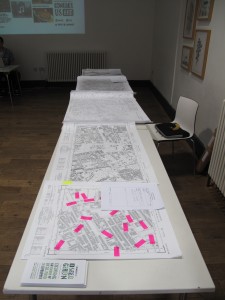
Alex’s paper maps table
The next session opened with a pair of films created by and starring a Manchester young women’s allotment group, with whom Mr Seel project member Niamh Moore has been working for some years. We were very happy that several of the group members were able to join us on the day, as they were excellent advertisements for the benefits of community growing, even if you ‘don’t really like vegetables’. As the films showed, even a humble lettuce, when freshly picked can become an exquisite taste sensation – and the strawberries sounded even better! You can view the films here and here. The films were followed by a second performance of the Mr Seel play.
The day concluded with a number of presentations by local growing groups, including John Hutchinson of the Faith Plot in Everton, Jenny Grigg from Fir Tree Community Growers near St Helens and Jean Grant and Anna Ryan from Growing Granby. These represented the wealth and diversity of growing projects in the Merseyside region, showing how grassroots activity can make a genuine difference to individual lives and community well-being. The importance of such local projects was underlined in the final talk, by Pete North, from the University of Liverpool, one of our friends from Transition Liverpool. Pete revealed plans for Liverpool to make a bid for Green Capital of Europe. As he admitted, Liverpool is not one of Europe’s most sustainable cities; as we know, it’s a poor city with many obstacles to creating a model for sustainable development. But the campaigning spirit of our community groups in particular could make it a model for other port cities in developing an economically and ecologically viable future. This is exactly the aim of the Mr Seel’s Garden project and so provided the perfect end to a really successful and exciting day.


